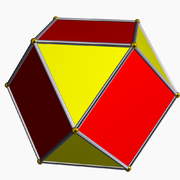- Truncated icosidodecahedron
-
Truncated icosidodecahedron 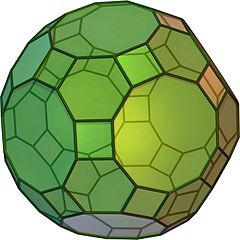
(Click here for rotating model)Type Archimedean solid
Uniform polyhedronElements F = 62, E = 180, V = 120 (χ = 2) Faces by sides 30{4}+20{6}+12{10} Schläfli symbol t0,1,2{5,3} Wythoff symbol 2 3 5 | Coxeter-Dynkin 




Symmetry Ih, [5,3], (*532) Dihedral Angle hexagon-decagon: 142.62°
square-decagon: 148.28°
hexagon-square: 159.095°References U28, C31, W16 Properties Semiregular convex zonohedron 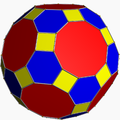
Colored faces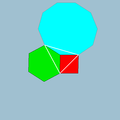
4.6.10
(Vertex figure)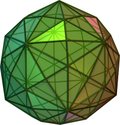
Disdyakis triacontahedron
(dual polyhedron)
NetIn geometry, the truncated icosidodecahedron is an Archimedean solid, one of thirteen convex isogonal nonprismatic solids constructed by two or more types of regular polygon faces.
It has 30 square faces, 20 regular hexagonal faces, 12 regular decagonal faces, 120 vertices and 180 edges – more than any other nonprismatic uniform polyhedron. Since each of its faces has point symmetry (equivalently, 180° rotational symmetry), the truncated icosidodecahedron is a zonohedron.
Contents
Other names
Alternate interchangeable names include:
- Truncated icosidodecahedron (Johannes Kepler)
- Rhombitruncated icosidodecahedron (Magnus Wenninger[1])
- Great rhombicosidodecahedron (Robert Williams,[2] Peter Cromwell[3])
- Omnitruncated dodecahedron or icosahedron (Norman Johnson)
The name truncated icosidodecahedron, originally given by Johannes Kepler, is somewhat misleading. If one truncates an icosidodecahedron by cutting the corners off, one does not get this uniform figure: instead of squares the truncation has golden rectangles. However, the resulting figure is topologically equivalent to this and can always be deformed until the faces are regular.
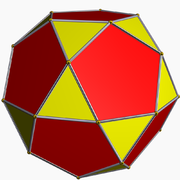
Icosidodecahedron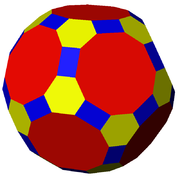
A literal geometric truncation of the icosidodecahedron produces rectangular faces rather than squares.The alternative name great rhombicosidodecahedron (as well as rhombitruncated icosidodecahedron) refers to the fact that the 30 square faces lie in the same planes as the 30 faces of the rhombic triacontahedron which is dual to the icosidodecahedron. Compare to small rhombicosidodecahedron.
One unfortunate point of confusion is that there is a nonconvex uniform polyhedron of the same name. See nonconvex great rhombicosidodecahedron.
Area and volume
The surface area A and the volume V of the truncated icosidodecahedron of edge length a are:
Truncated icosidodecahedron is the largest solid among all 13 Archimedean solids with the same side lengths.
Cartesian coordinates
Cartesian coordinates for the vertices of a truncated icosidodecahedron with edge length 2τ − 2, centered at the origin, are all the even permutations of:[4]
- (±1/τ, ±1/τ, ±(3+τ)),
- (±2/τ, ±τ, ±(1+2τ)),
- (±1/τ, ±τ2, ±(−1+3τ)),
- (±(-1+2τ), ±2, ±(2+τ)) and
- (±τ, ±3, ±2τ),
where τ = (1 + √5)/2 is the golden ratio.
Orthogonal projections
The truncated icosidodecahedron has seven special orthogonal projections, centered on a vertex, on three types of edges, and three types of faces: square, hexagonal and decagonal. The last two correspond to the A2 and H2 Coxeter planes.
Orthogonal projections Centered by Vertex Edge
4-6Edge
4-10Edge
6-10Face
squareFace
hexagonFace
decagonImage 
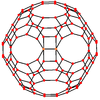


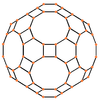
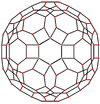
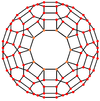
Projective
symmetry[2]+ [2] [2] [2] [2] [6] [10] Spherical tiling
The truncated icosidodecahedron can also be represented as a spherical tiling, and projected onto the plane via a stereographic projection. This projection is conformal, preserving angles but not areas or lengths. Straight lines on the sphere are projected as circular arcs on the plane.
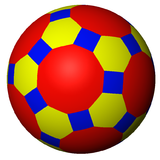
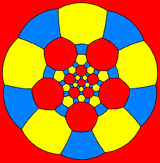
Decagon-centered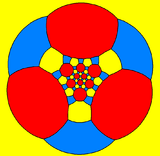
Hexagon-centered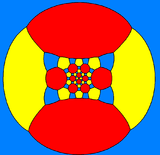
square-centeredSpherical tiling Stereographic projections (face-centered) See also
- Spinning great rhombicosidodecahedron
- dodecahedron
- great truncated icosidodecahedron
- icosahedron
- truncated cuboctahedron
Notes
- ^ Wenninger, (Model 16, p. 30)
- ^ Williamson (Section 3-9, p. 94)
- ^ Cromwell (p. 82)
- ^ Weisstein, Eric W., "Icosahedral group" from MathWorld.
References
- Wenninger, Magnus (1974), Polyhedron Models, Cambridge University Press, ISBN 978-0-521-09859-5, MR0467493
- Williams, Robert (1979). The Geometrical Foundation of Natural Structure: A Source Book of Design. Dover Publications, Inc. ISBN 0-486-23729-X.
- Cromwell, P.; Polyhedra, CUP hbk (1997), pbk. (1999).
- Eric W. Weisstein, GreatRhombicosidodecahedron (Archimedean solid) at MathWorld.
- Richard Klitzing, 3D convex uniform polyhedra, x3x5x - grid
External links
- Editable printable net of a truncated icosidodecahedron with interactive 3D view
- The Uniform Polyhedra
- Virtual Reality Polyhedra The Encyclopedia of Polyhedra
Polyhedron navigator Platonic solids (regular) Archimedean solids
(Semiregular/Uniform)truncated tetrahedron · cuboctahedron · truncated cube · truncated octahedron · rhombicuboctahedron · truncated cuboctahedron · snub cube · icosidodecahedron · truncated dodecahedron · truncated icosahedron · rhombicosidodecahedron · truncated icosidodecahedron · snub dodecahedronCatalan solids
(Dual semiregular)triakis tetrahedron · rhombic dodecahedron · triakis octahedron · tetrakis cube · deltoidal icositetrahedron · disdyakis dodecahedron · pentagonal icositetrahedron · rhombic triacontahedron · triakis icosahedron · pentakis dodecahedron · deltoidal hexecontahedron · disdyakis triacontahedron · pentagonal hexecontahedronDihedral regular Dihedral uniform Duals of dihedral uniform Dihedral others Degenerate polyhedra are in italics.Categories:- Uniform polyhedra
- Archimedean solids
- Zonohedra
Wikimedia Foundation. 2010.

![\begin{align}
A & = 30 \left [ 1 + \sqrt{ 2 \left ( 4 + \sqrt{5} + \sqrt{15+6\sqrt{6}} \right ) } \right ] a^2 \\
& \approx 175.031045a^2 \\
V & = ( 95 + 50\sqrt{5} ) a^3 \approx 206.803399a^3. \\
\end{align}](1/b81b5960eaa6189f90a713ac81b6a892.png)





